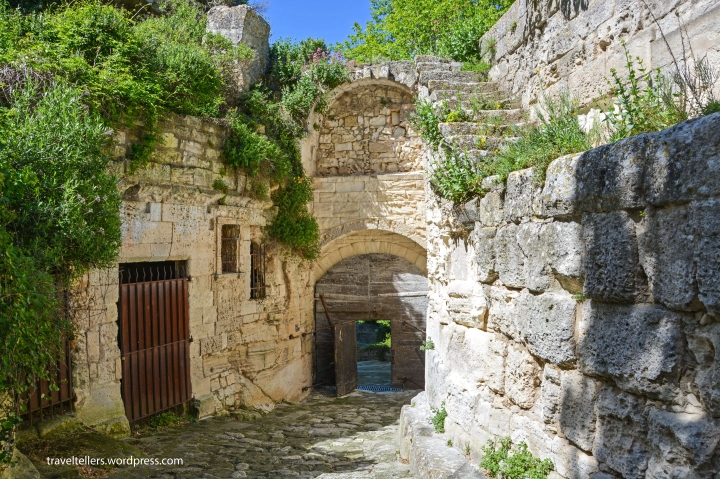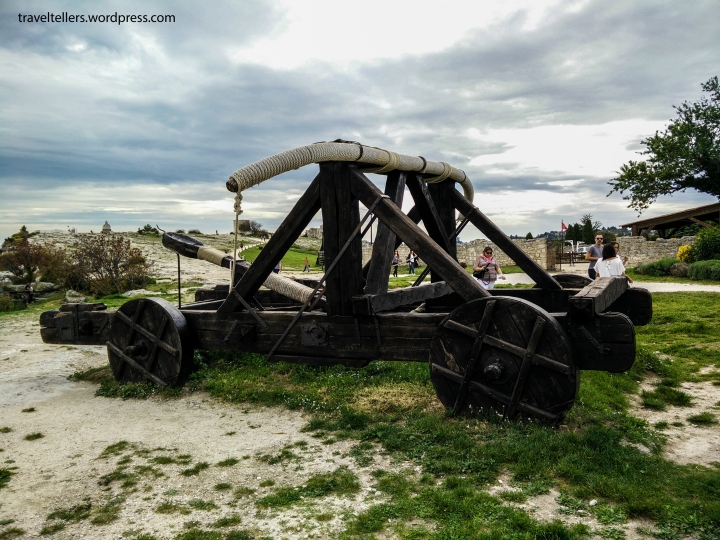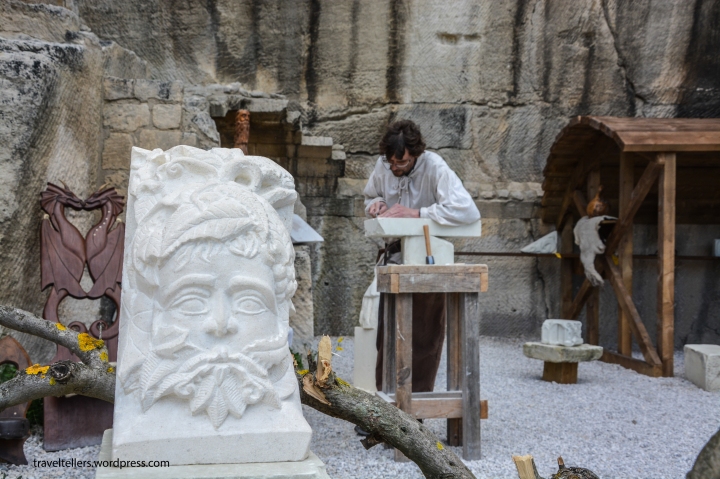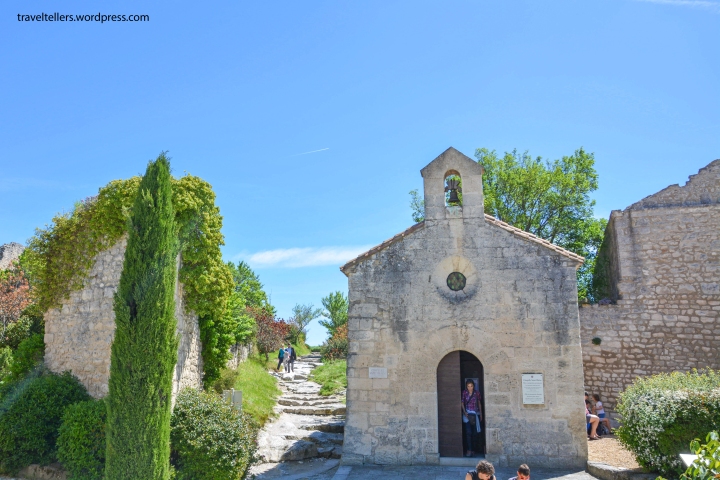One of our many takeaways from this trip was that no matter how much you plan ahead, sometimes you are guided only by luck. Pont du Gard was something which we desperately wanted to see during our stay in Provence. Twice we made plans to visit it and twice we failed, all due to an ill-timed bus strike. But those missed chances opened two other marvellous opportunities for us. One opportunity resulted in a magnificent visit to the ancient town of Glanum while the other allowed us to have a glimpse of medieval France at Les Baux.
So we were sitting at the Avignon bus station on our last morning in the Provence, cursing the bus and our luck as we realized that we would have to leave without seeing the iconic Pont du Gard. Le Baux was an alternate destination that we had kept in mind owing to our previous experiences with the bus system in Provence. The reason we hadn’t planned a visit to Les Baux initially was that the best way (and most of the times the only way) to reach Les Baux is by a car and since we were on a budget we were hesitant about hiring a cab. While we were at the bus station, we decided to check the bus timetable once just for the sake of it and, lo and behold, we found that the bus which took us to Saint-Rémy a couple of days ago extended its service up to Les Baux (and all the way to Arles) in the summer months (May – September). In May, June and September it runs on weekends while in July and August it runs every day.
So what date was it that day? 2nd May, 2015.
What day was it that day? Saturday.
Basically our last day in Provence was the first day of 2015 when the summer bus up to Les Baux had started running. We couldn’t have gone there on 1st May; we couldn’t have gone there on 3rd May. Didn’t I write above about something called luck!
The journey to Les Baux took one hour with the stretch from Saint-Rémy to Les Baux through the Alpilles being especially scenic.
LES BAUX-DE-PROVENCE
Once we saw Les Baux we were extremely glad that we did not miss it. Located in the countryside, surrounded by the Alpilles and vast fields of olive plantations, and perched atop a rocky cliff, Les Baux consists of the ruins of a medieval fortress known as Château des Baux and a village lying at the foot of the fortress. In fact, Bauxite, the chief ore of aluminium, was first discovered at Les Baux and it is from the village that Bauxite derived its name.
Our bus dropped us on the main road and from there we walked uphill passing the parking lot and finally reaching the village. The first building we saw on entering the village was the tourism office outside which there was a map of the village with all the important places marked on it. We clicked a photo of the map and navigated the village with its help.
The village of Les Baux did not lack any modern amenities with many shops, stores and cafes available for the tourists but there was an unmistakable medieval feel about it accentuated by the sloping narrow cobblestoned streets, the stone houses and buildings, a 12th century church, an old gate which served as the sole entry point to the village till almost a century ago and some other interesting structures.





We strolled around the village and saw all the places marked on the map. We also got some fantastic views of the valley and the Alpilles.
CHÂTEAU DES BAUX: AGE OF EMPIRES RELOADED
All those who have played Age of Empires (especially the first couple of versions) will probably agree with me that one of the most alluring and thrilling aspects of the game was the use of siege weapons. Anyone who has watched a medieval war movie would also agree that the dread or delight one feels, (depending on which side you are rooting for) as trebuchets and catapults launch projectile after projectile demolishing everything in their path or as the huge doors of castles shudder from the persistent assault of a battering ram, is unparalleled. Thus, imagine our excitement when we saw those deadly siege war machines displayed in the open in the château complex. And now imagine our excitement when we got to know that some of those machines were not mere models on display but they were actually functional with a few demonstrations held every day at specific timings.






This brings us to our oft-repeated point of how developed the tourism industry of Europe is and the lengths to which they go for tourist engagement. We experienced it in Interlaken, in Nimes, in Glanum and now in Les Baux. If taken in isolation, the fortress was nothing more than a ruined medieval structure (albeit in a pretty location) and would not have drawn many tourists but it has been converted into one of the most famous sites in the region.
The demonstration of siege weapons like trebuchet and couillard was only a small part of the attraction. Apart from that there were other demonstrations and performances like crossbow shooting and sword fighting between performers dressed in medieval clothes and armour. There were a couple of workshops dedicated to a stonemason who was making beautiful sculptures and designs on stone (tourists could even buy them) and a blacksmith who was forging swords and other weapons. These shows were entertaining and engaging but the best thing about them was that the performers enlisted tourists and took their help during most of these shows. For example, there was a show titled Passage of arms in which a person had to put on the full armour and then wield and display various medieval weapons. Instead of the professionals doing it themselves they chose people from audience for the same which certainly made it more fun.


The highlight and the most imposing structures of the fortress were the Keep and the two towers – Sarrasine Tower and Paravelle Tower. The ascent to these structures was not the easiest and required negotiating some narrow, irregular steps. The keep and the Sarrasine Tower were built on the top of the cliff and provided breathtaking views of the entire château complex and the surrounding valley containing olive plantations. The Paravelle Tower provided views of the other side which included the village and the rocky Alpilles.




Other than these structures, the fortress consisted of the remains of a chapel, cistern, houses, rooms, courtyards and caves. A very unique feature of the fortress was pigeonholes. The pigeonholes were hundreds of small square shaped cavities dug in large rocky walls which served as homes for pigeons.

The château complex also contained remains of a windmill, a hospital and a 12th century chapel known as Chapelle Saint Blaisi. A short movie played inside this chapel showing an aerial view of the important monuments and beautiful landscapes of Provence. After six days in Provence, we recognized some of the monuments but so many places still remained, waiting to be explored by us. Unfortunately, this was our last day in Provence and once we had seen the entire fortress, we walked back all the way to the main road. As our bus approached, we looked back one last time at that relic of medieval age and said a wistful Au Revoir to Provence and France.



Interesting Article! Loved the pictures!
LikeLike
Oh, I am loving your descriptions of Provence. I will be there towards the end of the month and after reading your posts I am more excited than ever! I have wanted to visit ever since I read Mary Stewart’s novel ‘Madam, Will You Talk?’ – this takes in Avignon, the Pont du Gard, Nimes (including the 3 in 1 ticket even though the book was written in 1954!), Les Baux and Marseille and we plan to visit all these places, hopefully. But it sounds as though we will not have your luck with public transport to Les Baux in March, which is good to know in advance.
Thank you for sharing these great posts.
LikeLike
Thank you. You surely have enough reasons to be excited about your trip. Regarding Les Baux, you can hire a cab to visit it. The shows there certainly offer something very different. If you are interested in history and archeology then do not miss excavations of Glanum. Best of luck with your trip 🙂
LikeLiked by 1 person
Thank you very much for these tips, appreciate it
LikeLiked by 1 person